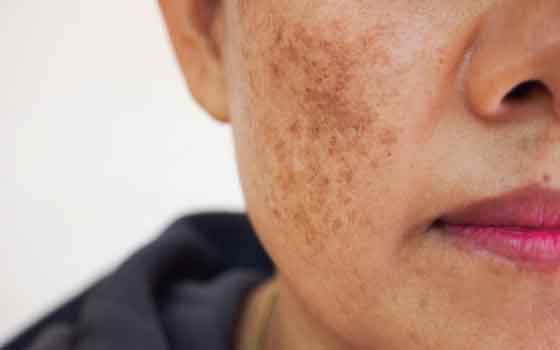Skin discoloration refers to the variations in the normal skin tone or skin color on different parts of the human body. Discolored skin patches can appear due to some genetic conditions that are almost impossible to prevent. However, there are many other possible reasons for the skin to become darker or lighter than the normal skin color. These causes include injury, medicine reactions, inflammation, underlying disorders, burns, allergies, hormonal imbalance, autoimmune disorders, skin cancer, and many more. Sometimes the reactions to cosmetic products and the presence of birthmarks are also categorized under skin discoloration.
One of the most common causes of dark skin discoloration is the increase in the levels of melanin. Basically, melanin is the pigment that provides color to our skin. Thus, when the levels of melanin increase, the color of the skin darkens in certain areas. Similarly, the decrease in melanin production can result in light skin patches on the skin. Some common reasons for an increase in melanin production include excessive sun exposure, hormonal changes, inflammation, Addison’s disease, and aging.
What Is Brown Skin Discoloration?
Brown skin discoloration is a condition in which dark brown patches appear on some specific areas of your skin. Most commonly, appear on legs, face, forehead, ankles, and sometimes the neck area. Also, in some cases, the person may feel irritation, irritation, rigidity, or pain in the affected area. Brown skin discoloration is a common condition that can affect anyone at any age. However, by identifying the underlying cause, it can easily be treated by an expert dermatologist.
Common Causes Of Brown Skin Discoloration
Various probable causes can result in discolored brown patches in different areas of the human body. Here are some of the most common brown skin discoloration causes that you must know.
- Overexposure To The Sun

Melanin overproduction is the most common known cause of brown colored patches on the skin. On being excessively exposed to the Sun’s ultraviolet rays (UV), the production of melanin in the skin increases rapidly. As melanin pigment gives the skin its color, its overproduction results in the darkening of the exposed skin areas. Furthermore, the most severe cases of over-exposure to the sun may result in blistering burns or sunburns.
- Melasma

Melasma is another common skin problem, in which brownish patches appear on the face of the person. It’s commonly found in females rather than males. The triggering factors of this skin problem include sun overexposure and hormonal imbalances.
- Melanoma

Melanoma is a lethal type of skin cancer, which requires immediate medical attention if a person notices its symptoms. The origin point of this skin cancer is the cells called melanocytes. As this cancer can spread through organs quickly, it’s considered to be very deadly. In melanoma, a person might notice an odd growth or increase in the size of an old mole. The affected person might also observe brown discoloration on the face, legs, and other body areas. There are four different types of melanoma, depending upon their respective symptoms. The types include Superficial Spreading Melanoma, Nodular Melanoma, Lentigo Maligna Melanoma, and Acral Lentiginous Melanoma.
Here are some of the verified symptoms of melanoma that everyone should watch out for.
- Irritation or itching on a mole, that eventually leads to bleeding
- The size of a mole increases more than its usual size
- The mole changes into a multicolored one
- Odd shaped mole
- Brown discoloration of the skin or in the area around the mole
If you experience any of these symptoms, it’s highly recommended that you get an immediate checkup done. An experienced and specialist dermatologist can help in controlling and treating the cancerous cells from spreading inside the body.
- Diabetes

An excess amount of insulin in the bloodstream can lead to the development of dark spots on specific body areas. In some diabetes patients, a resistance to the prescribed insulin is also observed. Thus, insulin is not properly utilized by the body and results in dark skin patches. These patches can be seen on the neck, armpits, groin, and other body areas of the affected person.
This brown skin discoloration on the neck and other areas due to excessive insulin presence is known as Acanthosis Nigricans (AN). To treat this condition, medications might be prescribed by your doctor to treat the underlying problem.
- Infections Or Post Inflammatory Hyperpigmentation

Skin inflammation can be triggered by skin conditions like infections, wounds, injuries, or acne on specific parts of your skin. This inflammation can result in hyperpigmentation, which results in the darkening of the skin color. Similarly, the overproduction of melanin due to injuries or skin inflammation can lead to the appearance of dark skin patches. For example, a cut or an open injury on the ankles is prone to get infected with harmful bacteria. This can further lead to an abnormal increase in the melanin levels, which ultimately results in brown skin discoloration on ankles.
- Other Causes
Not all the causes of getting dark patches on the skin are known or are common. Thus, here are two of the rare disorders that can cause changes in skin texture.
- Addison’s Disorder

Addison’s disorder is the rarely known cause that can cause hyperpigmentation on the skin areas. This miainly caused due to overproduction of the Melanocyte-Stimulating Hormone (MSH). The MSH is known to over-stimulate melanin-producing cells called melanocytes. Thus, the overproduction of melanin results in the appearance of dark skin patches on the skin. These patches can appear anywhere on the body, especially the ones that are directly exposed to sunlight. The treatment involves the use of steroid hormones to replace the ones not being produced by the adrenal glands.
- Tinea Versicolor

Tinea versicolor is a specific type of fungal infection that often leads to the appearance of brown discolored patches. The affected areas might include arms, chest, back, neck, face, and thighs. The discolored patches can be either dark or light than the normal skin color. The treatment options for this skin condition include antifungal creams, topical creams, and medicinal lotions.
Brown Skin Discoloration On Lower Legs

Reddish or brown skin discoloration on lower legs can be due to the malfunctioning of the veins. Blood flows between the heart and different body parts through our veins. Thus, our veins act as the carrier that regulates the blood flow in the body. But when this valve gets damaged, it enables the blood to flow back from the heart to other body parts. Eventually, the veins get swollen and create unusually high pressure in the legs and other lower body parts. This is why brown stains might appear on lower legs, ankles, and feet.
Brown discoloration on lower legs and other lower body areas might also be caused by hemosiderin staining. This brownish pigment is a byproduct of hemoglobin, and its accumulation can often result in dark skin discoloration. Other causes for dark discoloration on legs include Venous Stasis Dermatitis and Chronic Venous Insufficiency. If you observe brown discoloration on legs, ankles, or feet, get immediate medical help from an experienced dermatologist for treatment.
Brown Skin Discoloration On Ankles

Like lower legs, brown skin discoloration on ankles might be caused due to the same causes as mention above. These causes include malfunctioning of the veins, venous stasis dermatitis, chronic venous insufficiency, and hemosiderin staining. Chronic venous insufficiency with venous hypertension can often lead to the development of leg ulcers. Venous stasis dermatitis is commonly observed in middle-aged and elderly patients. In this condition, discoloration usually appears in the inner sides of the patient’s ankles.
With proper medical treatment, you can easily get rid of skin discoloration. Also, a person with discolored ankles is highly recommended to avoid sitting for long hours. Also, keeping the legs elevated while resting is also important. Furthermore, the affected person is also advised to do maximum ankle exercises like walking and running.
Brown Discoloration On Face

One of the most common conditions that cause brown discoloration on the face is known as Melasma. Melasma basically refers to the excessive production of melanin in the skin. As melanin pigment provides color to our skin, its overproduction results in dark discolored patches on the skin. This condition is most commonly found in women than men. The causes of this skin disorder include hormonal changes, excessive sun exposure, inflammation, injuries, infections, Addison’s disease, and aging, etc.
The treatment options include the application of hydroquinone and azelaic acid cream on the discolored skin areas. Also, it’s highly advised to prevent going out in the sun to prevent this problem from worsening. There are various home remedies that you can use to treat this skin problem at home too. The home remedy options include aloe vera, tranexamic acid, glutathione, and sunscreen lotions, etc.
Brown discoloration on neck

Brown discoloration on the neck is a common skin disorder, which may be a consequence of different underlying problems. In some cases, the discolored skin patches appear due to some medicinal allergies, reactions, or side-effects. Another very common reason for the discolored neck is a skin condition called Acanthosis Nigricans (AN). This is basically caused by underlying problems like tumors, obesity, diabetes, etc. In the AN, a person might experience changes in the skin texture like skin thickening, darkening, and softening.
To treat this problem, the treatment of underlying problems like obesity, diabetes, or tumors. Also, people suffering from this discoloration can use home remedies like apple cider vinegar, baking soda, and potato juice, etc.
Conclusion
So this was everything you need to know about brown skin discoloration on the face, neck, lower legs, and ankles. Dark skin patches or skin discoloration can be both harmless and lethal, depending upon the underlying cause. Thus, it highly recommends to keep a note of any changes in your skin color or unusual growths on the skin. If you experience any of the above-mentioned symptoms or signs, consult a dermatologist as soon as possible. After that, you can get proper medical treatment or use the recommended home remedies to treat the problem. As it’s said, prevention is better than cure, the same applies to the dark skin discoloration problem too.



